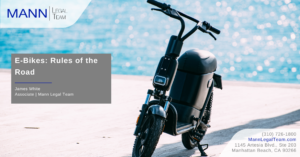E-Bikes: Rules of the Road
May 17, 2023Of the many Pandemic-era novelties—including mask mandates, work from home, and the resurgence of outdoor dining—perhaps none is more pronounced in Southern California than the proliferation of electric bicycles (“e-bikes”). From the streets to the Strand, they are seemingly everywhere. In 2020 alone, Manhattan Beach saw e-bike sales soar more than 900%. Unfortunately, this meteoric rise in sales coincided with frightening increases in e-bike accident occurrences and severity statewide. In response, the State of California and many local governments have imposed new e-bike legislation to promote safe ridership.
Types of E-Bikes
In California, e-bikes can be separated into three categories. Class 1 e-bikes require pedal input and have a top speed of 20 mph; Class 2 e-bikes can operate without pedal input and have a top speed of 20 mph; and Class 3 e-bikes require pedal input but may have a top speed of 28 mph. Cal. Veh. Code. § 312.5. In no case may the e-bike have a motor wattage greater than 750, and the manufacturer is required to affix a label to each bike indicating which category it falls into. Id. If an e-bike falls into one of those categories, the rider need not have a driver’s license or carry liability insurance. If an e-bike does not fall into one of the three classes, it may be considered a motor-driven cycle, a motorized bicycle, or a motorized scooter, each of which requires a valid driver’s license and liability insurance coverage.
Rules of the Road
Riders of any class of e-bike are permitted on public roadways but must obey all traffic laws as if they were riding a traditional bicycle or driving a car. Id. § 21200. Among other things, that means e-bike riders must obey all traffic lights, stop signs, and posted speed limits, may not wear headphones or earbuds, and may not ride while under the influence of alcohol or other drugs. For Class 1 & 2 e-bikes, riders must wear a helmet if they are under the age of 18, while riders of Class 3 e-bikes must be at least 16 years old and must always wear a helmet regardless of their age. In addition, riders should not carry passengers except in a dedicated, permanent seat.
On the road, e-bike riders must ride as close to the right-hand curb as possible unless they are keeping pace with the normal speed of traffic. Exceptions to this rule exist where the rider is preparing for a left turn, or where reasonably necessary to avoid an obstacle. From a practical standpoint, this means that e-bike riders, just like any other cyclist, should always stay near the curb to allow faster traffic to pass unless they are capable of riding at or near the speed limit.
Liability and Insurance Coverage
If you’re in an accident involving an e-bike, are you insured? Many homeowners’ and renters’ insurance policies provide coverage for incidents involving bicycles, but the coverage often excludes e-bikes. Similarly, while your auto insurance policy provides liability coverage if you are in a car accident, it may decline to provide coverage if you were riding an e-bike. Therefore, it is important to review your coverage before setting foot on the pedals.
© Copyright 2021. MANN LEGAL TEAM All rights reserved.

